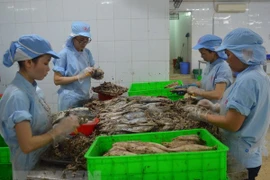Hai Phong (VNA) – The northern port city ofHai Phong has rolled out several measures to support and form value chains for itsagro-fisheries products.
According to Dinh Cong Toan, Vice Director of themunicipal Department of Agriculture and Rural Development, the department plansto work with relevant agencies to expand markets for major products and those withstrong trademarks and origin certificates.
The city will strengthen links among producers,enterprises, supermarkets, shops and consumers, he said.
Toan revealed that Hai Phong will work to lureinvestors to agriculture, especially high-tech agriculture, while developingthe product information and traceability system for farm produce.
He said the department will also expand satellite farmerhouseholds in cultivation, breeding and aquaculture to serve the demand of enterprises,individuals and organisations in fostering connectivity in production andselling of farm produce.
The locality will allocate capital from agricultural andrural development programmes and projects to good farming models in concentratedproduction regions as well as to the building of goods’ trademarks, he added.
A report by the Hai Phong Department of Agricultureand Rural Development showed that in the first half of 2018, the city’sagricultural and aquatic production expanded 2.81 percent from the same periodin 2017.
To form goods value chains, the city has developed 385concentrated production regions covering more than 7,800 hectares, including 277regions for cultivation, 27 for breeding and 78 for aquatic farming.
The sector has built more than 100 high-techagricultural models, along with more than 10 agriculture-tourism models.
In the first six months of 2018, Hai Phong formed 47close production-selling chains, built the Hai Phong Agricultural Produce tosupport the selling and promotion of local products and received certificatesof origin for 51 products.
However, the department also pointed to weaknesses in seekingmarkets for its products, along with inefficient activities to connectproducers, enterprises, supermarkets, shops and consumers, high production costsand difficulties in storing fresh products.-VNA




























